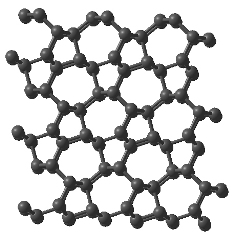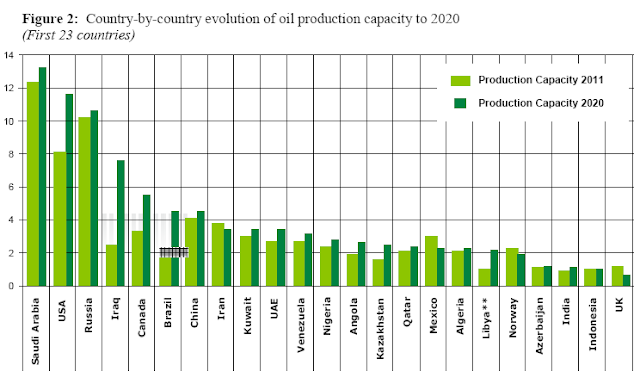Click here to read this mailing online.
|
China and the USA partner for molten salt thorium reactor project and India plans a Thorium Reactor1. The U.S. Department of Energy is quietly collaborating with China on an alternative nuclear power design known as a molten salt reactor that could run on thorium fuel.
China plans to have a 5 megawatt molten salt reactor in 2015. DOE’s assistant secretary for nuclear energy Peter Lyons is co-chairing the partnership’s executive committee, along with Jiang Mianheng from the Chinese Academy of Sciences (CAS), according to a March presentation by CAS on thorium molten salt reactors. Beijing-based CAS is a state group overseeing about 100 research institutes. It and the DOE have established what CAS calls the “CAS and DOE Nuclear Energy Cooperation Memorandum of Understanding.” 2. India Atomic Energy Commission (AEC) chairman R K Sinha said - India is planning to establish a nuclear power plant that uses thorium as main fuel instead of uranium, which is used in conventional reactors. Read more » Lawrenceville Plasma Physics makes progress on science and soon should have big experimental improvementsHere is a 6 page progress report on the Dense Plasma Focus fusion work at Lawrenceville Plasma Physics (LPP)
Every doubling of current means 30 times power. So some relatively simple modifications which are being developed should boost power levels by 300 times. Total elimination of arcing, which they are working on now, may drop the resistance to as low as 2 mOhms. Full power, shorter electrodes, and our existing switches, FF-1 will produce over 2.3 MA, over twice our current output. New, faster switches now under design for LPP by Raytheon will get us the rest of the way to our goal of 2.8 MA. In May, 2012, the LPP plan for the next 12 months was laid out. Read more » Wages for Executives, Managers and Professionals in China are Near US levelsForbes - Based on 2011 salaries, some Chinese workers are earning as much as their American counterparts.
Position Annual Salary (US$) Engineering supervisor 25,000 – 42,000 General manager 130,000 – 330,000 R and D director 100,000 – 167,000 Procurement director 67,000 – 150,000 Quality director 67,000 – 150,000 Chief technology officer 167,000 – 330,000 Marketing director 100,000 – 130,000 PR/communications manager 34,000 – 67,000 Regional sales manager 67,000 – 100,000 Source: Hays 2012 Salary Guide – Asia Of course, most Chinese do not have professional jobs, and minimum wage and social safety net comparisons to the U.S. are dismal. The federal minimum wage level in the U.S. is $7.25 per hour. A 40 hour work week means $290 a week gross for the lowest full-time workers in America. In Shenzhen and Shanghai, two of the highest earning cities in China, minimum wage is $238 and $230, respectively…per month.There is 25 page salary survey from Gemini. It quotes monthly salary ranges by position in RMB. Read more » High Speed Robotic Vision Enables a Robotic Hand to Always beat Humans at Rock, Paper ScissorsIEEE Spectrum - A robot (from the Ishikawa Oku Lab at the University of Toyko) is unbeatable at rock, paper scissors. It's one of those high speed hands that works with a high speed vision system. And when we say 'high speed,' we mean fast enough that you can't really tell that the robot is cheating.
It only takes a single millisecond for the robot to recognize what shape your hand is in, and just a few more for it to make the shape that beats you. 
Ishikawa Oku Lab website Read more » New Leap Motion Controller VideoTechnology Review - Leap Motion will launch a $70 superaccurate gesture control system that simply plugs into any computer and, apparently, just works. If you've seen the gesture interfaces in Minority Report, you know what it does. More importantly, if you're familiar with the touch modality -- and at this point, most of us are -- the interface is entirely intuitive.
Verge has the technical details on the Leap Motion Controller The Leap uses a number of camera sensors to map out a workspace of sorts — it's a 3D space in which you operate as you normally would, with almost none of the Kinect's angle and distance restrictions. Currently the Leap uses VGA camera sensors, and the workspace is about three cubic feet; Holz told us that bigger, better sensors are the only thing required to make that number more like thirty feet, or three hundred. Leap's device tracks all movement inside its force field, and is remarkably accurate, down to 0.01mm. It tracks your fingers individually, and knows the difference between your fingers and the pencil you're holding between two of them. Read more » Google Glasses can only be bought at I/O Developers conferenceCNN Money - Google's science-fiction-like virtual reality glasses will start shipping next year with a price tag of $1,500 -- but most buyers won't be able to get their hands on a pair just yet.
The under-development glasses, a stealth project hatched in the company's mysterious Google X lab, are still buggy, Google co-founder Sergey Brin said Wednesday at Google's I/O developer conference. Google also faces regulatory hurdles that prevent the glasses from being shipped anywhere but the United States. Read more » Theoretical M-Carbon matched to Superhard compressed GraphiteResearchers used a novel computational method to demonstrate that the properties of what had previously been thought to be only a hypothetical structure of a superhard form of carbon called “M-carbon” – constructed by Oganov in 2006 – matched perfectly the experimental data on “superhard graphite.” M-carbon is almost as hard as diamond.
Another result of this study is a set of detailed mechanisms of formation of several potential carbon allotropes. These could be used to engineer ways of their synthesis for potential technological applications. “We don't know yet which applications M-carbon will find, but most forms of carbon did manage to find revolutionary applications, and this amazing material might do so as well,” said Oganov. The story of yet another form of carbon started in 1963, when Aust and Drickamer compressed graphite at room temperature. High-temperature compression of graphite is known to produce diamond, but at room temperature an unknown form of carbon was produced. This new form, like diamond, was transparent and superhard - but its other properties were inconsistent with diamond or other known forms of carbon. The new work confirms that experiments produced M-carbon, which has a known structure. Read more » Jerry Pournelle linked to a Nextbigfuture article by Joseph FriedlanderJerry Pournelle linked to an article by Joseph Friedlander from Chaos Manor
Jerry Pournelle said - There is a long bit on McNamara and the Strategy of Technology http://nextbigfuture.com/2012/05/where-did-future-go-strategy-of.html which will be worth the attention of those interested in those subjects. The article is - Where did the future go-- The Strategy of Technology and The Space Race, McNamara and LBJ and the Lost Future of 2001. Abstract of the article- Robert McNamara killed X-plane experimentation. Technological development needs a lot of trial and error with rapid build and test and modify iterations. By removing rapid development cycles the cost of technology has increased and the pace of technology has slowed. This has become a fundamental flaw in many US technology development programs. There is a lot of links and extracts from Freeman Dyson and Jerry Pournelle about the flaws in Technology Development policy which are traced back to what McNamara did. wikipedia - Jerry Eugene Pournelle (born August 7, 1933) is an American science fiction writer, essayist and journalist who contributed for many years to the computer magazine Byte. Since 1998, Pournelle has maintained a website with a daily online journal, "View from Chaos Manor", a blog dating from before the use of that term. This is a continuation of his 1980s blog-like online journal on GEnie. He says he resists using the term blog because he considers the word ugly and because he maintains that his "View" is primarily a vehicle for writing rather than a collection of links. Read more » Google Nexus 7 and Nexus Q announced at Google IOThe Google IO conference has had the announcement of the $199 Google Nexus 7 tablet and the Nexus Q for $299. They are also showing off the google glasses. Google's Nexus Q is a streaming media player. Nexus 7 is a 7 inch tablet.
Android 4.1, Jelly Bean was announced as well. Android has crossed 400 million activations. 20 billion apps have been downloaded from Google Play. Nexus 7 The 7-inch tablet will come pre-loaded with Android 4.1 Jelly Bean, Google's latest operating system. Available in black or white, an 8GB version will be priced at $199, with 16GB for $249. A quad-core Tegra 3 processor, 1280 x 800 IPS display, 1.2-megapixel camera, 1GB of RAM, and a 4,325mAh battery. It is made by ASUS. Nexus Q Social Streaming Media Appliance The Verge -The Nexus Q, an audio and video streaming appliance for users at home. It's a cloud-oriented device, designed to pull media from the Google Play Store as well as YouTube. The Q delivers the media to your television or a set of external speakers — it features a 25-watt amplifier as well — and is powered by the same chipset as the Galaxy Nexus. It features ethernet, Bluetooth, and NFC connectivity, and owners will be able to use their Android devices to control the streamer. Optical audio and micro-HDMI output are included, and the device also features banana-style connectors for connecting speakers. 
Read more » VoiceTra4U-M will translate 31 languages and is Ready for the London OlympicsU-Star is a spinoff from the Singapore government A*Star research institute. U-Star has a translation application. The Universal Speech Translation Advanced Research Consortium is an international research consortium conducting research and development on a network-based speech-to-speech translation (S2ST) system, with the aim of breaking the language barriers of the world. U-STAR are implemented with ITU-T standardization protocols, F.745 and H.625.
This application is the multi-device application "VoiceTra4U-M." It helps multiple users (up to 5) communicate in different languages, in real time either face to face or remotely. U-STAR has also initially focused on translating words and phrase related to tourism, making it 80 to 90 per cent accurate versus Google's 40 to 60 per cent accuracy - though of course, this accuracy falls if you want to discuss a topic not covered by the app. Read more » India Nuclear Reactor Project News Roundup1. Business Standard - Work on additional two 500 MW prototype fast breeder reactor units at BHAVINI at Kalpakkam, India would commence by 2015
Kumar said around Rs 2500 crore has been spent so far on the project, which began in 2009. Read more » 1200 Megawatt fast reactor approved for BeloyarskWorld Nuclear News - The government of the Sverdlovsk region of Russia has approved the construction of the country's first BN-1200 fast reactor at the Beloyarsk nuclear power plant. The unit will be built to replace the existing smaller BN-600 reactor at the plant, which is scheduled to be shut down by 2020.
The government said that the planned 1200 MWe unit will produce around 9 billion kilowatt-hours of electricity annually and help avoid the emission of "millions of tonnes" of carbon dioxide. In addition, it would completely remove the region's need to import fossil fuels. With a 60-year operating life, the reactor is expected to have an annual capacity factor of at least 90%. Read more » Harvard Study Predicts World Oil Production at 110 million barrel per day in 2020Oil: The Next Revolution, The Unprecedented Upsurge of Oil Production Capacity and What it means for the World. (86 pages) The figure is an all oil liquids prediction (which includes crude oil, natural gas liquids, biofuels etc...).
The natural endowment of the initial American shale play, Bakken/Three Forks (a tight oil formation) in North Dakota and Montana, could become a big Persian Gulf producing country within the United States. But the country has more than twenty big shale oil formations, especially the Eagle Ford Shale, where the recent boom is revealing a hydrocarbon endowment comparable to that of the Bakken Shale. Most of U.S. shale and tight oil are profitable at a price of oil (WTI) ranging from $50 to $65 per barrel, thus making them sufficiently resilient to a significant downturn of oil prices. Read more » More Recent Articles |





